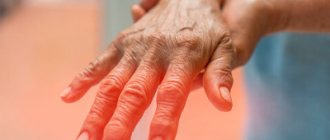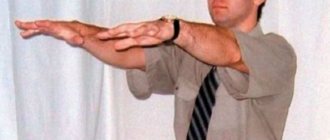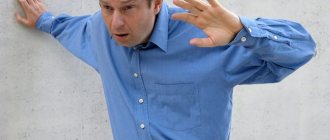Psychogenic dizziness
Currently, such “classical” functional disorders of the nervous system as hysterical paralysis and blindness have practically disappeared. They were replaced mainly by somatoform disorders, including those manifested by dizziness, which tend to have a protracted course. Statistics of visits to the clinic of nervous diseases of the Military Medical Academy named after. CM. Kirov of patients with complaints of dizziness shows that psychogenic dizziness ranks third among other clinical forms. Moreover, it can develop as part of a depressive or neurotic state, schizophrenia, panic attack, phobia, hysteria, somatoform dysfunction of the autonomic nervous system, etc.
Despite the fact that psychogenic dizziness should always remain a diagnosis of exclusion, it is important to timely diagnose this condition, explain to the patient the reasons for his complaints, and prescribe adequate treatment. Below we will consider one of the most common types of psychogenic dizziness encountered in clinical practice - phobic postural dizziness.
Phobic postural vertigo
“Fobic postural vertigo” (PPD) is a clinical syndrome that includes, firstly, dizziness, described by patients as “fog in the head”, unsteadiness, a feeling of intoxication, which are usually associated with special conditions (descending stairs, walking along a busy street, at night) or situations that are perceived by the patient as provoking factors (being in the subway, a public place, driving a car), secondly, anxiety and autonomic reactions (nausea, vomiting, lability of pulse and blood pressure) and third, avoidance behavior in relation to these situations in the absence of objective clinical signs of organic neurological disorders.
FPG is typical for obsessive-compulsive individuals and usually develops after significant irritation of the vestibular apparatus (especially with benign paroxysmal positional vertigo, vestibular neuronitis) or stress.
Clinic
FIG is characterized by attacks of imbalance and fear, which occur without episodes of actual falls (falls are possible that precede the formation of a secondary FIG), but with the formation of avoidant behavior.
The severity of symptoms decreases when the patient is distracted, as well as after taking small doses of alcohol, and in some patients, during sports. The quality of life of patients with FPG decreases significantly as vegetative-somatic symptoms generalize and the patient’s social maladjustment increases. In the premorbid character structure, predominantly obsessive traits and perfectionism are revealed, predisposing to the formation of stable obsessive-compulsive disorders and psychogenic depression.
The manifestations of FPG largely correspond to the structure of panic disorder, including recurrent anxiety attacks, obsessive fear of a recurrence of the attack accompanied by dizziness, as well as avoidance behavior. It should, however, be borne in mind that fear of repeated dizziness with avoidant behavior can also be observed in patients with vestibular dysfunction, which makes it possible to distinguish between primary and secondary panic disorder, which develops on the basis of otological pathology.
Diagnostics. For differential diagnosis, it is important to conduct a comprehensive examination of such patients (MRI of the brain, consultation with a neurologist, ENT doctor), exclude possible concomitant somatic pathology (endocrine disorders, anemic syndrome, arrhythmias, etc.), and convince the patient of the benign nature of his disease. Indeed, sometimes such patients find themselves without the help of specialists: otorhinolaryngologists exclude their pathology, therapists and neurologists also do not find any significant deviations, which further fixes the patient on his own experiences, creating the feeling that he has a “rare, incomprehensible” disease with a dubious prognosis for life. recovery. The diagnostic criteria for FPG are given in the table.
Treatment
The basis of therapy for patients with FPG should be a combination of medicinal and non-medicinal (psychotherapy, vestibular and breathing exercises) treatment methods. First-line drugs are antidepressants (selective serotonin reuptake inhibitors - paroxetine, venlafaxine - and tricyclic antidepressants - amitriptyline). Benzadiazepines (phenazepam, diazepam, alprazolam, etc.) are also used. In some cases, a positive effect in the treatment of anxiety disorders is achieved with the use of “minor” antipsychotics (sulpiride, tiapride, thioridazine). As an additional therapy, the drug betahistine is used, which reduces the excitability of the vestibular apparatus and is effective for all types of dizziness, including psychogenic. Treatment of underlying somatic and neurological pathology that leads to deterioration of postural and vestibular functions (for example, treatment of diabetes mellitus, vitamin B12 deficiency, hypo- or hyperthyroidism) is mandatory.
← Back
Diagnostics
A thorough examination and an equally detailed collection of anamnesis and complaints are the most important components of the diagnosis of hyperventilation syndrome. The disease always causes a large number of complaints about the functioning of certain systems and organs, which can immediately lead to the idea of hyperventilation syndrome. However, a final diagnosis can only be made if organic diseases of the organs and systems that the patient complains about are excluded. To confirm their absence, additional procedures are prescribed: ultrasound of the abdominal organs, ECG, ultrasound of the heart, spirography and others.
Careful questioning of the patient usually reveals certain anxieties, high emotional stress and other changes. This is called a positive psychogenic analysis, which also leads the doctor to think about hyperventilation syndrome.
The disease can be detected using a simple and free method that does not require special equipment. The patient needs to breathe frequently and deeply for 5 minutes. If hyperventilation syndrome is truly present, then the symptoms will begin to manifest themselves. Since when symptoms of the disease appear, the amount of carbon dioxide in the exhaled air and blood decreases, after the onset of symptoms the patient needs to breathe air with a 5% carbon dioxide content (in a clinical setting) or breathe into a plastic bag. This will help relieve symptoms.
Medical researchers have developed a unique questionnaire, the results of which can diagnose the disease in 9 out of 10 cases.
The diagnosis of hyperventilation syndrome cannot be made on the basis of one specific symptom and the results of additional studies that refute the problem with the disturbing organ or system. After all, disorders of the respiratory system may also indicate the presence of a number of other diseases, much more terrible (heart failure, bronchial asthma, and so on). Only the doctor’s individual approach to the patient, combined with modern research techniques and a complete comprehensive examination, will help make the only correct diagnosis.
How is normal anxiety different from a panic attack?
The mechanism that triggers a panic attack is no different from what causes ordinary anxiety - both are psychophysical reactions to danger. The difference is that a panic attack is a reaction to danger in the absence of danger. However, a false alarm triggers the same cascade of reactions as a normal alarm - the sympathetic system is activated, and adrenaline is released.
A panic attack can occur due to excessive physical activity, fatigue and exhaustion, as well as due to the abuse of stimulants and alcohol. In addition, stress and unresolved conflict situations can trigger an attack. A lack of understanding of one's own experiences and feelings, a tendency to avoid and ignore negative emotions also increase vulnerability to panic disorder.
How to treat panic attacks and when to see a specialist
It is necessary to contact a specialist if you have recurring panic attacks. Therapy is selected individually and, as a rule, includes psychotherapeutic work and drug therapy. Psychotherapy involves various techniques aimed at recognizing and understanding the causes of problems, teaching ways to deal with the symptoms of the disease, and relaxation methods. Psychotherapy can take place in the form of individual meetings with a psychotherapist or in the form of group sessions with other patients. Drug therapy for panic disorder is carried out with various drugs that help reduce the level of anxiety and fear. Prescription, dosage adjustment and discontinuation of treatment must be carried out under the supervision of a physician.
Modern neurotechnologies can also help in the treatment of panic attacks. Methods of neurofeedback training have been developed for patients with panic disorder. During the trainings, patients learn to manage their emotional state, they form new neural connections, and their anxiety level decreases. In addition to professional help, lifestyle plays a significant role in the treatment and prevention of panic attacks. Try not to abuse alcohol and caffeine, get more rest, go in for sports, preferably yoga.
Source: https://www.wmj.ru/krasota/telo/golovokruzhenie-zhar-i-dazhe-udushe-simptomy-panicheskikh-atak-i-kak-s-nimi-borotsya-razbiraem-s-vrachom.htm
Back to list
Treatment of weakness, dizziness and drowsiness
Medical neurologists have extensive experience in the differential diagnosis and treatment of neuroses. The patient can count on professional assistance, from the first visit to complete recovery. Doctors carry out complex treatment depending on the indications, or rather on the results obtained during the examination.
Any medications for neurosis should be taken as prescribed by a doctor.
To cure neurosis, you will need:
- Drug therapy. The doctor prescribes drugs to correct mood, drugs that improve brain function.
- Psychotherapeutic treatment. It involves eliminating the emerging symptom complex through communication with a psychotherapist. The patient is prescribed group or individual psychotherapy sessions, which are a mandatory component of treatment.
Kazieva Aminat Ziyavovna
Neurologist
Rostov State Medical University
Experience since 2012
Treatment for dizziness, tinnitus, and fatigue primarily focuses on addressing the underlying cause. The doctor must make adjustments to the patient’s lifestyle. During treatment, clinical recommendations should be followed:
- get enough sleep;
- avoid stress, heavy physical labor and emotional overload;
- take breaks from mental work;
- learn relaxation techniques;
- relax after a hard day at work: take a bath, drink warm tea, go for a massage;
- to walk outside;
- to refuse from bad habits.
To strengthen the body, you may need to take vitamin and mineral supplements, adjust your diet, namely include vegetables and fruits in your diet, and avoid unhealthy foods. Dietary nutrition is important for atherosclerosis, hypertension, and other diseases of the heart and blood vessels. Along with the diet, antihypertensives, nootropics, and drugs that lower blood cholesterol levels are prescribed.
If noise in the head and dizziness are caused by osteochondrosis, then drug treatment is supplemented with physiotherapeutic procedures, among which manual therapy is the most effective.
Kazieva Aminat Ziyavovna
Neurologist
Rostov State Medical University
Experience since 2012
For diseases of the hearing aid, antibiotics, magnetic therapy and other physical procedures may be required.
Symptoms of the disease
Symptoms of anxiety-phobic disorder include:
- Panic attacks are a sudden strong fear of danger, death, causing autonomic disorders in the patient: dizziness, fainting, nausea, lack of air, tachycardia.
- Agoraphobia – fear of public places, crowds, the street.
- Hypochondriacal phobias are fear of the possibility of illness, intense search for symptoms, panic and confidence in the inevitability of illness at the slightest detection.
- Social phobias – fear of being evaluated by other people, fear of close attention from others.
- Other phobias: fear of heights, touching, confined spaces, elements, certain situations.
For a person prone to phobias to manifest them, it is enough to remember and imagine similar situations or a previous attack. Phobias tend to develop: embarrassment during speeches in front of the public or management, with the aggravation of obsessive states, is transformed into a fear of ordinary communication with well-known people.
Obsessive-phobic disorder: risk group
People with certain qualities are predisposed to anxiety-phobic disorder: anxiety, low self-esteem, pedantry. At risk are perfectionists who constantly evaluate their activities and accompany them with a detailed mental algorithm, as well as psychasthenics who are prone to suspiciousness and excessive introspection.
It is extremely rare that anxiety-phobic disorder is found in people who tend to shift responsibility for what is happening to others, who do not spare others in order to achieve their goals, or who are aggressive.
The gender of a person does not matter for the statistics of the disease, but a certain age (teenagers and young adults, as well as the age preceding menopause) increases the risk of its development.
Course of obsessive-phobic neurosis
There are several variants of the course of anxiety-phobic disorder:
1) attacks of panic attacks, as a rule, are not accompanied by manifestations of other phobias;
2) a combination of panic attacks and persistent agoraphobia, while in the manifestation of panic attacks, strong fear prevails over the physical manifestations of the phobia. A person can take extreme measures (a complete change of activity, moving, changing contacts) to level out the possibility of new panic attacks;
3) vegetative manifestations of panic attacks prevail over the severity of fear and subsequently provoke attacks of hypochondriacal phobias.
Treatment of anxiety-phobic disorders in Samara
Anxiety-phobic disorder (other names - obsessive-phobic disorder, obsessional neurosis, obsessive-phobic neurosis) is a neurotic disorder that causes phobias, obsessive (obsessive) states, sudden fears and thoughts. Obsessive states torment the patient, but he cannot get rid of them without outside help.









